Evaluation of the Soil Conservation Service Curve Number (SCS-CN) Method for Flash Flood Runoff Estimation in Arid Regions: A Case Study of Central Eastern Desert, Egypt
Abstract
1. Introduction
2. Description of the Study Area
3. Data
3.1. Precipitation Data
3.2. Optical and Radar Images
3.3. Topographic Maps
3.4. Digital Elevation Models (DEMs)
3.5. Geologic Maps
4. Methods
4.1. SCS-CN Method
4.2. GPM-FR Data Processing
4.3. Land Cover
4.4. Vegetation
4.5. Hydrological Soil Groups (HSGs)
4.6. The Antecedent Moisture Condition (AMC)
5. Results and Discussions
5.1. The Rainfall Analysis
5.2. Land Cover, NDVI, and HSG Properties
- (1)
- HSG (A): includes fine-textured sandy soil with a large thickness and good drainage. It has high infiltration rates even when completely wet, and therefore has low runoff potential. These soils have a high water transmission rate > 7.62 mm/h [67], and represent 9.7% of the total basin area.
- (2)
- HSG (B): consists mainly of medium and coarse gravel deposits of medium to large thickness and is characterized by moderate infiltration rates when the soil is wet. These soils have a moderate water transmission rate of 3.81 to 7.62 mm/h [67], and account for 14.2% of the total basin area.
5.3. Determine the CN Values
5.4. SCS-CN Results
5.5. Model Evaluation
5.5.1. Tracing the Flash Flood
5.5.2. Runoff from the Integration of RS, TIN DEMs, and Field Measurements
5.5.3. Estimating the Volume of Runoff from SCS-CN
5.6. Evaluating the Current Protection Methods
6. Conclusions
Author Contributions
Funding
Data Availability Statement
Acknowledgments
Conflicts of Interest
References
- Alcántara, I.; Goudie, A.S. Geomorphological Hazards and Disaster Prevention; Cambridge University Press: Cambridge, UK, 2010. [Google Scholar]
- Richardson, D. International Encyclopedia of Geography, 15 Volume Set: People, the Earth, Environment and Technology; John Wiley & Sons: Hoboken, NJ, USA, 2017; Volume 1. [Google Scholar]
- Huggett, R.; Shuttleworth, E. Fundamentals of Geomorphology; Routledge: London, UK, 2022. [Google Scholar]
- Sene, K. Flood Warning, Forecasting and Emergency Response; Springer Science & Business Media: Berlin/Heidelberg, Germany, 2008. [Google Scholar]
- Dimitriou, E.; Efstratiadis, A.; Zotou, I.; Papadopoulos, A.; Iliopoulou, T.; Sakki, G.-K.; Mazi, K.; Rozos, E.; Koukouvinos, A.; Koussis, A.D. Post-Analysis of Daniel Extreme Flood Event in Thessaly, Central Greece: Practical Lessons and the Value of State-of-the-Art Water-Monitoring Networks. Water 2024, 16, 980. [Google Scholar] [CrossRef]
- Khalifa, A.; Bashir, B.; Alsalman, A.; Naik, S.P.; Nappi, R. Remotely Sensed Data, Morpho-Metric Analysis, and Integrated Method Approach for Flood Risk Assessment: Case Study of Wadi Al-Arish Landscape, Sinai, Egypt. Water 2023, 15, 1797. [Google Scholar] [CrossRef]
- Bajabaa, S.; Masoud, M.; Al-Amri, N. Flash flood hazard mapping based on quantitative hydrology, geomorphology and GIS techniques (case study of Wadi Al Lith, Saudi Arabia). Arab. J. Geosci. 2014, 7, 2469–2481. [Google Scholar] [CrossRef]
- Abushandi, E.; Al Sarihi, M. Flash flood inundation assessment for an arid catchment, case study at Wadi Al Jizzi, Oman. Water Pract. Technol. 2022, 17, 1155–1168. [Google Scholar] [CrossRef]
- Ashour, M.M. Flash floods in Egypt. Bull. Egypt. Geogr. Soc. 2002, LXXV, 101–114. [Google Scholar]
- El-Fakharany, M.; Mansour, N. Morphometric analysis and flash floods hazards assessment for Wadi Al Aawag drainage Basins, southwest Sinai, Egypt. Environ. Earth Sci. 2021, 80, 168. [Google Scholar] [CrossRef]
- Moawad, M.B. Analysis of the flash flood occurred on 18 January 2010 in wadi El Arish, Egypt (a case study). Geomat. Nat. Hazards Risk 2013, 4, 254–274. [Google Scholar] [CrossRef][Green Version]
- Abduladheem, A.; Elmewafey, M.; Beshr, A.; Elnaggar, A. Using GIS based morphometry estimation of flood hazard impacts on desert roads in South Sinai, Egypt. Int. J. Sci. Eng. Res. 2015, 6, 1593–1599. [Google Scholar]
- Elsadek, W.M.; Ibrahim, M.G.; Mahmod, W.E. Flash flood risk estimation of Wadi Qena Watershed, Egypt using GIS based morphometric analysis. Appl. Environ. Res. 2018, 40, 36–45. [Google Scholar] [CrossRef]
- Abd El Aal, A.; Kamel, M.; Al-Homidy, A. Using remote sensing and GIS techniques in monitoring and mitigation of geohazards in Najran Region, Saudi Arabia. Geotech. Geol. Eng. 2019, 37, 3673–3700. [Google Scholar] [CrossRef]
- Nasir, M.J.; Iqbal, J.; Ahmad, W. Flash flood risk modeling of swat river sub-watershed: A comparative analysis of morphometric ranking approach and El-Shamy approach. Arab. J. Geosci. 2020, 13, 1–19. [Google Scholar] [CrossRef]
- El-Fakharany, M.A.; Hegazy, M.N.; Mansour, N.M.; Abdo, A.M. Flash flood hazard assessment and prioritization of sub-watersheds in Heliopolis basin, East Cairo, Egypt. Arab. J. Geosci. 2021, 14, 1693. [Google Scholar] [CrossRef]
- Rashwan, M.; Mohamed, A.K.; Alshehri, F.; Almadani, S.; Khattab, M.; Mohamed, L. Flash Flood Hazard Assessment along the Red Sea Coast Using Remote Sensing and GIS Techniques. ISPRS Int. J. Geo-Inf. 2023, 12, 465. [Google Scholar] [CrossRef]
- Gabr, S.; El Bastawesy, M. Estimating the flash flood quantitative parameters affecting the oil-fields infrastructures in Ras Sudr, Sinai, Egypt, during the January 2010 event. Egypt. J. Remote Sens. Space Sci. 2015, 18, 137–149. [Google Scholar] [CrossRef]
- Ezz, H. Integrating GIS and HEC-RAS to model Assiut plateau runoff. Egypt. J. Remote Sens. Space Sci. 2018, 21, 219–227. [Google Scholar] [CrossRef]
- Mashaly, J.; Ghoneim, E. Flash flood hazard using optical, radar, and stereo-pair derived dem: Eastern desert, Egypt. Remote Sens. 2018, 10, 1204. [Google Scholar] [CrossRef]
- Hagras, A. Runoff modeling using SCS-CN and GIS approach in the Tayiba Valley Basin, Abu Zenima area, South-west Sinai, Egypt. Model. Earth Syst. Environ. 2023, 9, 3883–3895. [Google Scholar] [CrossRef]
- Hegazy, M.N.; El-Fakharany, M.A.A.; Abdo, A.M.; Mansour, N.M. Estimation of expected peak discharge and flood volume of the Heliopolis basin, East Cairo, Egypt, using RS and WMS program. Egypt. J. Remote Sens. Space Sci. 2023, 26, 676–690. [Google Scholar] [CrossRef]
- Zerger, A.; Smith, D.I. Impediments to using GIS for real-time disaster decision support. Comput. Environ. Urban Syst. 2003, 27, 123–141. [Google Scholar] [CrossRef]
- Al-Ghobari, H.; Dewidar, A.; Alataway, A. Estimation of surface water runoff for a semi-arid area using RS and GIS-based SCS-CN method. Water 2020, 12, 1924. [Google Scholar] [CrossRef]
- Shi, W.; Wang, N. An improved SCS-CN method incorporating slope, soil moisture, and storm duration factors for runoff prediction. Water 2020, 12, 1335. [Google Scholar] [CrossRef]
- Suresh Babu, P.; Mishra, S. Improved SCS-CN–inspired model. J. Hydrol. Eng. 2012, 17, 1164–1172. [Google Scholar] [CrossRef]
- Mishra, S.K.; Jain, M.K.; Suresh Babu, P.; Venugopal, K.; Kaliappan, S. Comparison of AMC-dependent CN-conversion formulae. Water Resour. Manag. 2008, 22, 1409–1420. [Google Scholar] [CrossRef]
- Jacobs, J.M.; Myers, D.A.; Whitfield, B.M. Improved rainfall/runoff estimates using remotely sensed soil moisture 1. JAWRA J. Am. Water Resour. Assoc. 2003, 39, 313–324. [Google Scholar] [CrossRef]
- Mishra, S.K.; Singh, V.P. Soil Conservation Service Curve Number (SCS-CN) Methodology; Springer Science & Business Media: Berlin/Heidelberg, Germany, 2013; Volume 42. [Google Scholar]
- Woodward, D.E.; Hawkins, R.H.; Jiang, R.; Hjelmfelt, J.; Allen, T.; Van Mullem, J.A.; Quan, Q.D. Runoff curve number method: Examination of the initial abstraction ratio. In Proceedings of the World Water & Environmental Resources Congress 2003, Philadelphia, PA, USA, 23–26 June 2003; pp. 1–10. [Google Scholar]
- Mishra, S.K.; Singh, V.P. Long-term hydrological simulation based on the Soil Conservation Service curve number. Hydrol. Process. 2004, 18, 1291–1313. [Google Scholar] [CrossRef]
- Satheeshkumar, S.; Venkateswaran, S.; Kannan, R. Rainfall–runoff estimation using SCS–CN and GIS approach in the Pappiredipatti watershed of the Vaniyar sub basin, South India. Model. Earth Syst. Environ. 2017, 3, 24. [Google Scholar] [CrossRef]
- Gheith, H.; Sultan, M. Construction of a hydrologic model for estimating Wadi runoff and groundwater recharge in the Eastern Desert, Egypt. J. Hydrol. 2002, 263, 36–55. [Google Scholar] [CrossRef]
- Milewski, A.; Sultan, M.; Yan, E.; Becker, R.; Abdeldayem, A.; Soliman, F.; Gelil, K.A. A remote sensing solution for estimating runoff and recharge in arid environments. J. Hydrol. 2009, 373, 1–14. [Google Scholar] [CrossRef]
- Masoud, A.A. Runoff modeling of the wadi systems for estimating flash flood and groundwater recharge potential in Southern Sinai, Egypt. Arab. J. Geosci. 2011, 4, 785–801. [Google Scholar] [CrossRef]
- Foody, G.M.; Ghoneim, E.M.; Arnell, N.W. Predicting locations sensitive to flash flooding in an arid environment. J. Hydrol. 2004, 292, 48–58. [Google Scholar] [CrossRef]
- Moawad, M.B.; Abdel Aziz, A.O.; Mamtimin, B. Flash floods in the Sahara: A case study for the 28 January 2013 flood in Qena, Egypt. Geomat. Nat. Hazards Risk 2016, 7, 215–236. [Google Scholar] [CrossRef]
- Abuzaid, A.S.; Abdellatif, A.D.; Fadl, M.E. Modeling soil quality in Dakahlia Governorate, Egypt using GIS techniques. Egypt. J. Remote Sens. Space Sci. 2021, 24, 255–264. [Google Scholar] [CrossRef]
- El-Etr, H.; Ashmawy, M. Flash flood vulnerability and mitigation of the Red Sea basins between Latitudes 24°41 and 25°26. In Proceedings of the International Conference on ‘‘30 years Coop. Geol. Surv.”, Egypt, Cairo; 1993; Volume 30, pp. 335–351. [Google Scholar]
- Badawy, M. Applications of Remote Sensing and Geographic Information Systems in Geomorphological Studies: Safaga-El Quseir Area, Red Sea Coast, Egypt as an Example. Ph.D. Dissertation, Mainz University, Mainz, Germany, 2008. [Google Scholar]
- Abdel-Fattah, M.; Kantoush, S.; Sumi, T. Integrated management of flash flood in wadi system of Egypt: Disaster prevention and water harvesting. Annu. Disas. Prev. Res. Inst. Kyoto Univ. 2015, 58, 485–496. [Google Scholar]
- Embabi, N.S. Landscapes and Landforms of Egypt; Springer: Berlin/Heidelberg, Germany, 2018. [Google Scholar]
- Egyptian, M.A. Normals for Meteorological Surface Station from 1981–2010; Meteorological Station: Cairo, Egypt, 2016. [Google Scholar]
- Baldi, M.; Amin, D.; Al Zayed, I.S.; Dalu, G. Climatology and dynamical evolution of extreme rainfall events in the Sinai Peninsula—Egypt. Sustainability 2020, 12, 6186. [Google Scholar] [CrossRef]
- Schumm, S.A. Evolution of drainage systems and slopes in badlands at Perth Amboy, New Jersey. Geol. Soc. Am. Bull. 1956, 67, 597–646. [Google Scholar] [CrossRef]
- Horton, R.E. Drainage-basin characteristics. Trans. Am. Geophys. Union 1932, 13, 350–361. [Google Scholar]
- Strahler, A.N. Quantitative geomorphology of drainage basin and channel networks. In Handbook of Applied Hydrology; McGraw-Hill: New York, NY, USA, 1964. [Google Scholar]
- Horn, B.K. Hill shading and the reflectance map. Proc. IEEE 1981, 69, 14–47. [Google Scholar] [CrossRef]
- Strahler, A.N. Quantitative analysis of watershed geomorphology. Eos Trans. Am. Geophys. Union 1957, 38, 913–920. [Google Scholar]
- Horton, R.E. Erosional development of streams and their drainage basins; hydrophysical approach to quantitative morphology. Geol. Soc. Am. Bull. 1945, 56, 275–370. [Google Scholar] [CrossRef]
- Chorley, R.J. The drainage basin as the fundamental geomorphic unit. In Introduction to Physical Hydrology; Routledge: London, UK, 2019; pp. 37–59. [Google Scholar]
- Shamy, E. Recent recharge and flash flooding opportunities in the Eastern Desert, Egypt; Possibilités de recharge de nappes et de crues subites dans le Désert Oriental, Egypte. Ann. Geol. Surv. Egypt 1992, 18, 323. [Google Scholar]
- Yousif, M.; Hussien, H.M. Flash floods mitigation and assessment of groundwater possibilities using remote sensing and GIS applications: Sharm El Sheikh, South Sinai, Egypt. Bull. Natl. Res. Cent. 2020, 44, 50. [Google Scholar] [CrossRef][Green Version]
- Arnous, M.O.; El-Rayes, A.E.; El-Nady, H.; Helmy, A.M. Flash flooding hazard assessment, modeling, and management in the coastal zone of Ras Ghareb City, Gulf of Suez, Egypt. J. Coast. Conserv. 2022, 26, 77. [Google Scholar] [CrossRef]
- Abou El-Magd, I.; Hermas, E.; El Bastawesy, M. GIS-modelling of the spatial variability of flash flood hazard in Abu Dabbab catchment, Red Sea Region, Egypt. Egypt. J. Remote Sens. Space Sci. 2010, 13, 81–88. [Google Scholar] [CrossRef]
- Elnazer, A.A.; Salman, S.A.; Asmoay, A.S. Flash flood hazard affected Ras Gharib city, Red Sea, Egypt: A proposed flash flood channel. Nat. Hazards 2017, 89, 1389–1400. [Google Scholar] [CrossRef]
- Hermas, E.; Gaber, A.; El Bastawesy, M. Application of remote sensing and GIS for assessing and proposing mitigation measures in flood-affected urban areas, Egypt. Egypt. J. Remote Sens. Space Sci. 2021, 24, 119–130. [Google Scholar] [CrossRef]
- Gado, T.A.; Elkollaly, M.; Guo, Y.; El-Hagrsy, R.M.; Mohameden, M.B.; Shalaby, B.A.; Elboshy, B.; Omara, H.; ElSawwaf, M.A. Event-based rainfall analysis in Sinai, Egypt. Hydrol. Sci. J. 2024, 69, 622–638. [Google Scholar] [CrossRef]
- Hou, A.Y.; Skofronick-Jackson, G.; Kummerow, C.D.; Shepherd, J.M. Global precipitation measurement. In Precipitation: Advances in Measurement, Estimation and Prediction; Springer: Berlin/Heidelberg, Germany, 2008; pp. 131–169. [Google Scholar]
- Hamouda, M.A.; Hinge, G.; Yemane, H.S.; Al Mosteka, H.; Makki, M.; Mohamed, M.M. Reliability of GPM IMERG Satellite Precipitation Data for Modelling Flash Flood Events in Selected Watersheds in the UAE. Remote Sens. 2023, 15, 3991. [Google Scholar] [CrossRef]
- Mahmoud, M.T.; Hamouda, M.A.; Mohamed, M.M. Spatiotemporal evaluation of the GPM satellite precipitation products over the United Arab Emirates. Atmos. Res. 2019, 219, 200–212. [Google Scholar] [CrossRef]
- Rachdane, M.; Khalki, E.M.E.; Saidi, M.E.; Nehmadou, M.; Ahbari, A.; Tramblay, Y. Comparison of high-resolution satellite precipitation products in sub-saharan Morocco. Water 2022, 14, 3336. [Google Scholar] [CrossRef]
- Aslami, F.; Ghorbani, A.; Sobhani, B.; Esmali, A. Comprehensive comparison of daily IMERG and GSMaP satellite precipitation products in Ardabil Province, Iran. Int. J. Remote Sens. 2019, 40, 3139–3153. [Google Scholar] [CrossRef]
- Sharifi, E.; Steinacker, R.; Saghafian, B. Assessment of GPM-IMERG and other precipitation products against gauge data under different topographic and climatic conditions in Iran: Preliminary results. Remote Sens. 2016, 8, 135. [Google Scholar] [CrossRef]
- Mahmoud, M.T.; Mohammed, S.A.; Hamouda, M.A.; Mohamed, M.M. Impact of topography and rainfall intensity on the accuracy of imerg precipitation estimates in an arid region. Remote Sens. 2020, 13, 13. [Google Scholar] [CrossRef]
- MSA. Egyptian Topographic Maps 1:25,000; Directorate of Military Survey, War Office and Air Ministry: London, UK, 2004. [Google Scholar]
- Cronshey, R. Urban Hydrology for Small Watersheds; US Department of Agriculture, Soil Conservation Service, Engineering Division: Washington, DC, USA, 1986.
- Pandit, A.; Regan, J. What is the Impervious Area Curve Number? J. Water Manag. Model. 1998, 23, R200-23. [Google Scholar] [CrossRef]
- Entezari, M.; Esmaeily, A.; Niazmardi, S. Estimation of soil moisture and earth’s surface temperature using landsat-8 satellite data. Int. Arch. Photogramm. Remote Sens. Spat. Inf. Sci. 2019, 42, 327–330. [Google Scholar] [CrossRef]
- Gaber, A.; Koch, M.; El-Baz, F. Textural and compositional characterization of Wadi Feiran deposits, Sinai Peninsula, Egypt, using Radarsat-1, PALSAR, SRTM and ETM+ data. Remote Sens. 2009, 2, 52–75. [Google Scholar] [CrossRef]
- Pishvaei, M.H.; Noroozpour, S.; Sabzevari, T.; Kheirabadi, M.A.; Petroselli, A. Spatial and temporal distribution of infiltration, curve number and runoff coefficients using TOPMODEL and SCS-CN models. J. Agric. Environ. Int. Dev. (JAEID) 2024, 118, 203–230. [Google Scholar] [CrossRef]
- Meresa, H. Modelling of river flow in ungauged catchment using remote sensing data: Application of the empirical (SCS-CN), artificial neural network (ANN) and hydrological model (HEC-HMS). Model. Earth Syst. Environ. 2019, 5, 257–273. [Google Scholar] [CrossRef]
- Salem, I.A.; AR, A.E.-E.; El-Shibiny, N.H. Geochemical and mineralogical characteristics of stream sediments of Wadi El-Baroud area Central Eastern Desert Egypt. Int. J. Innov. Eng. Technol. (IJIET) 2017, 2, 21–40. [Google Scholar]
- Dao, P.D.; Liou, Y.-A. Object-based flood mapping and affected rice field estimation with Landsat 8 OLI and MODIS data. Remote Sens. 2015, 7, 5077–5097. [Google Scholar] [CrossRef]
- Ahmed, M.R.; Rahaman, K.R.; Kok, A.; Hassan, Q.K. Remote sensing-based quantification of the impact of flash flooding on the rice production: A case study over Northeastern Bangladesh. Sensors 2017, 17, 2347. [Google Scholar] [CrossRef]
- Islam, M.M.; Ahamed, T. Development of a near-infrared band derived water indices algorithm for rapid flash flood inundation mapping from sentinel-2 remote sensing datasets. Asia-Pac. J. Reg. Sci. 2023, 7, 615–640. [Google Scholar] [CrossRef]
- Mujeeb, M. Estimation of Surface Runoff Using SCS-CN Remote Sensing and GIS in Sanjab Watershed. Available online: https://ouci.dntb.gov.ua/en/works/73E5o10l/ (accessed on 14 May 2024).
- Water Resources Research Institute (WRRI). Safaga City Protection Project from Flash Flood Hazards: Red Sea Governorate (Phase I), in Arabic; WRRI: Raleigh, NC, USA, 2003. [Google Scholar]
- Burt, T.; Boardman, J.; Foster, I.; Howden, N. More rain, less soil: Long-term changes in rainfall intensity with climate change. Earth Surf. Process. Landf. 2016, 41, 563–566. [Google Scholar] [CrossRef]
- El-Rawy, M.; Fathi, H.; Zijl, W.; Alshehri, F.; Almadani, S.; Zaidi, F.K.; Aldawsri, M.; Gabr, M.E. Potential Effects of Climate Change on Agricultural Water Resources in Riyadh Region, Saudi Arabia. Sustainability 2023, 15, 9513. [Google Scholar] [CrossRef]
- Hussain Shah, S.M.; Yassin, M.A.; Abba, S.I.; Lawal, D.U.; Hussein Al-Qadami, E.H.; Teo, F.Y.; Mustaffa, Z.; Aljundi, I.H. Flood Risk and Vulnerability from a Changing Climate Perspective: An Overview Focusing on Flash Floods and Associated Hazards in Jeddah. Water 2023, 15, 3641. [Google Scholar] [CrossRef]
- Nabinejad, S.; Schüttrumpf, H. Flood risk management in arid and semi-arid areas: A comprehensive review of challenges, needs, and opportunities. Water 2023, 15, 3113. [Google Scholar] [CrossRef]
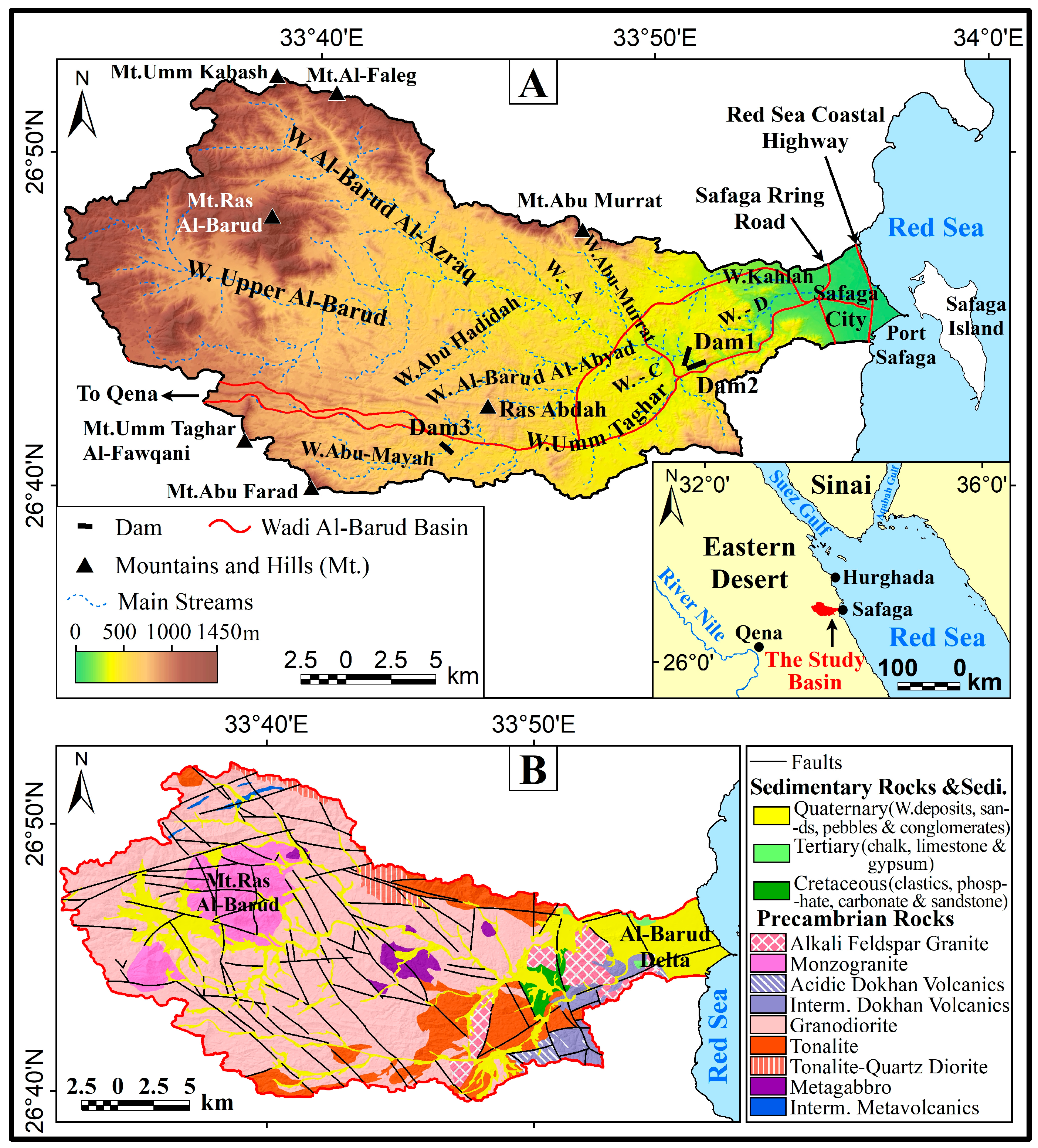
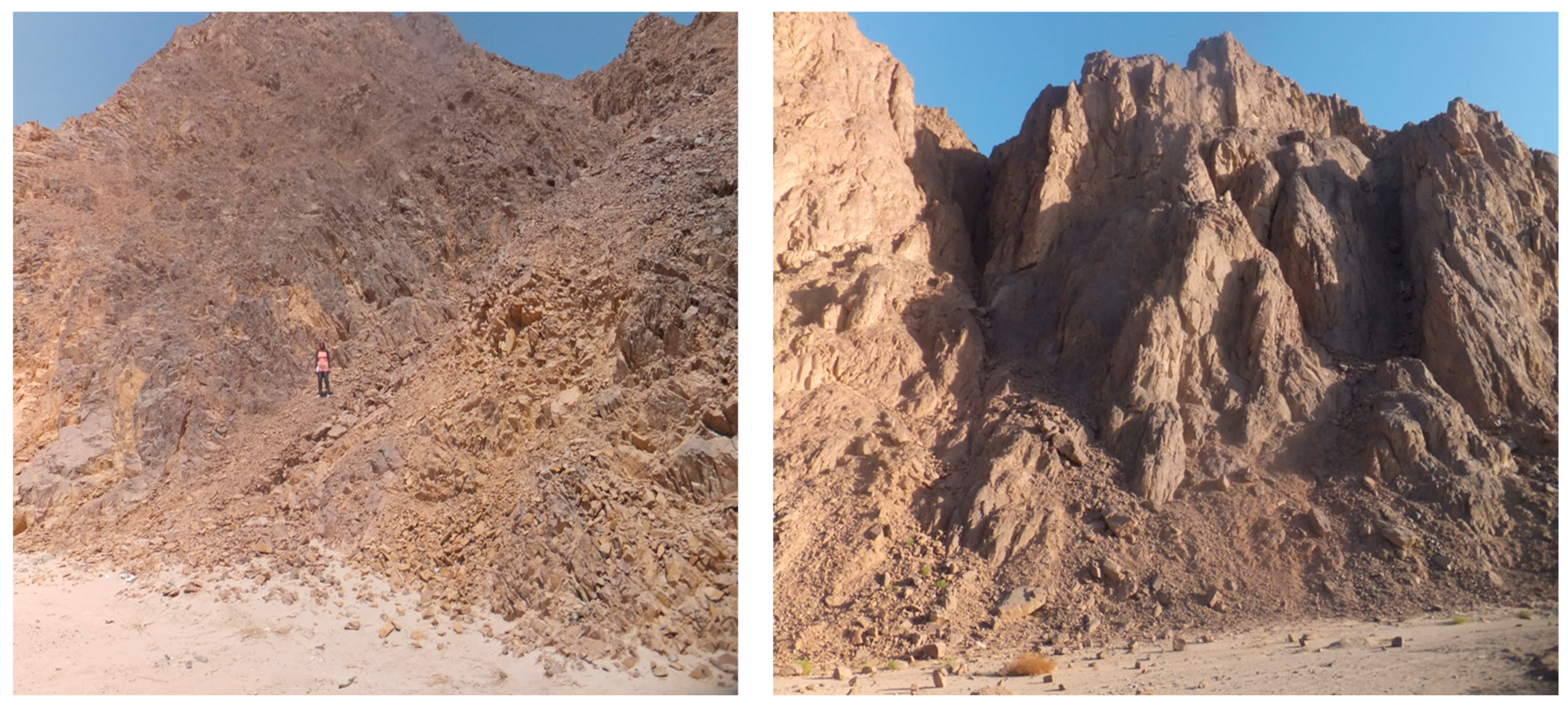
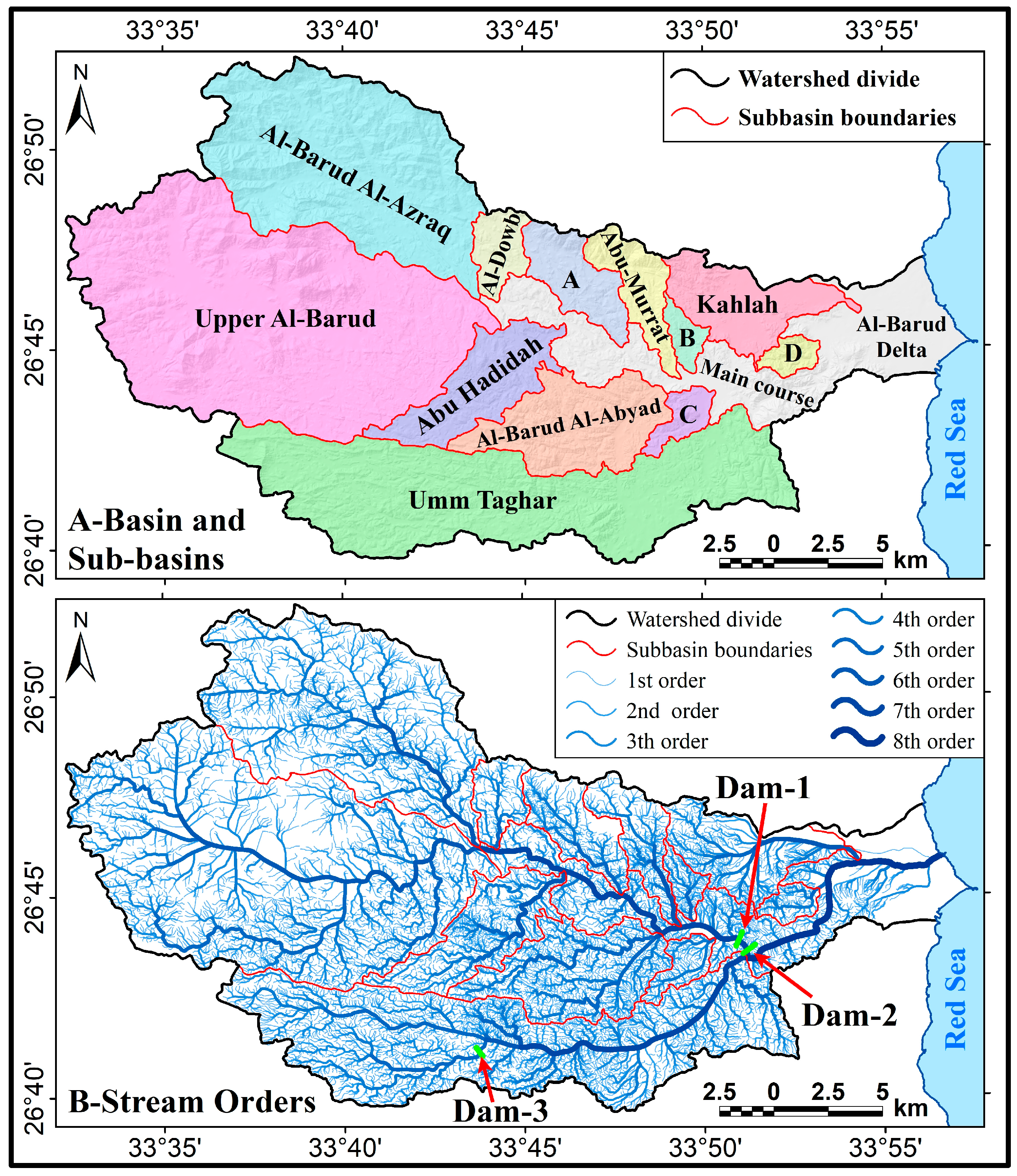
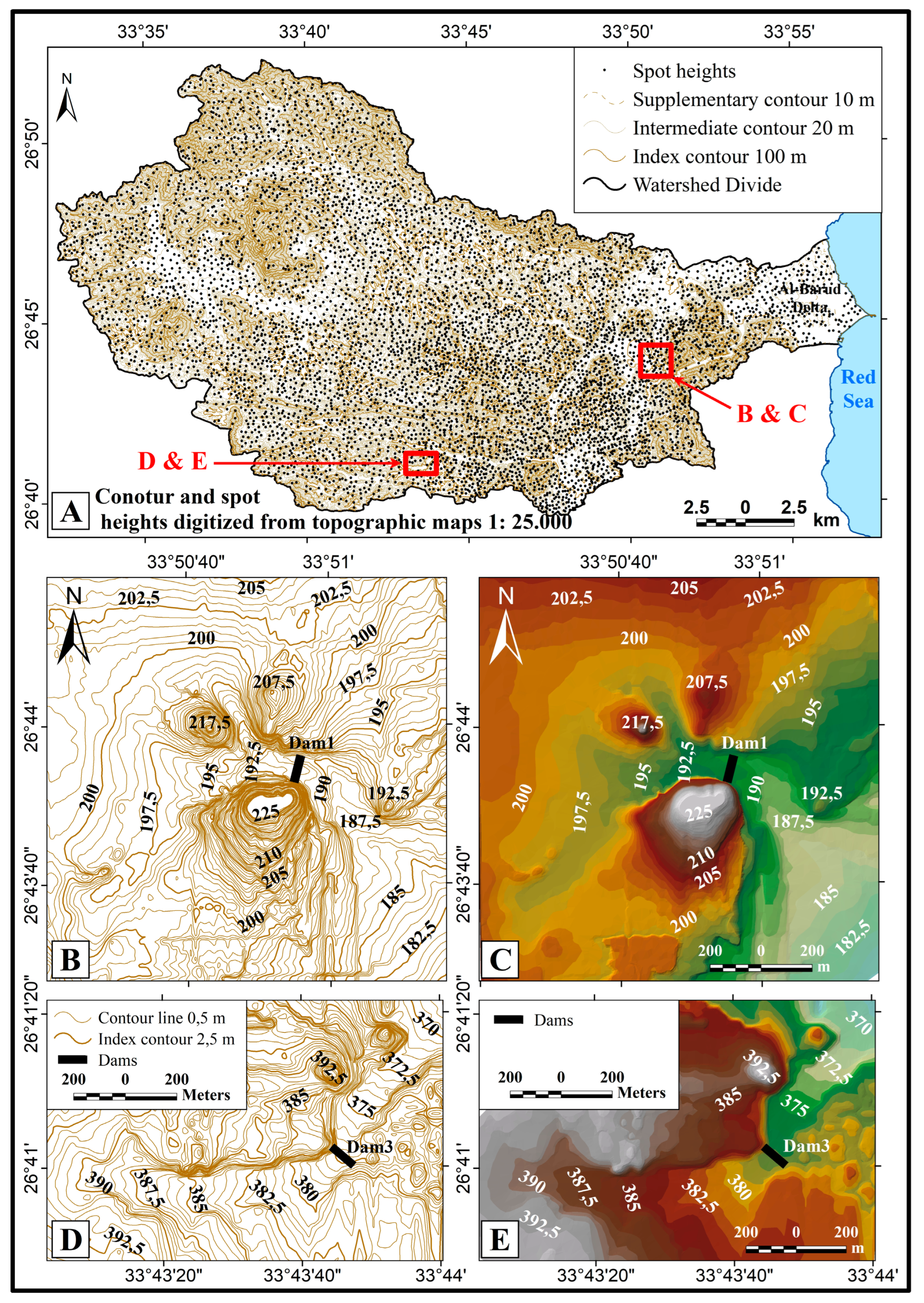
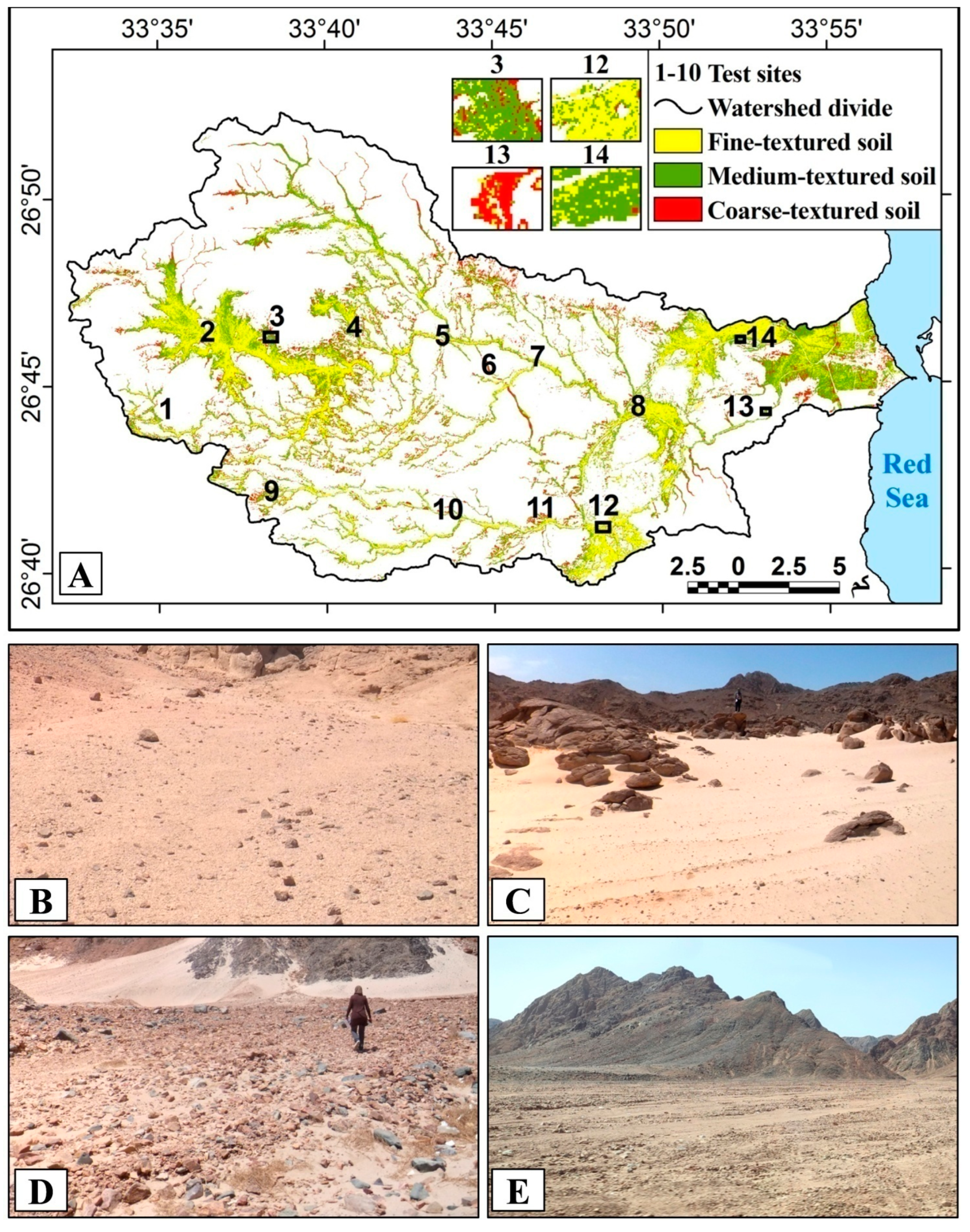
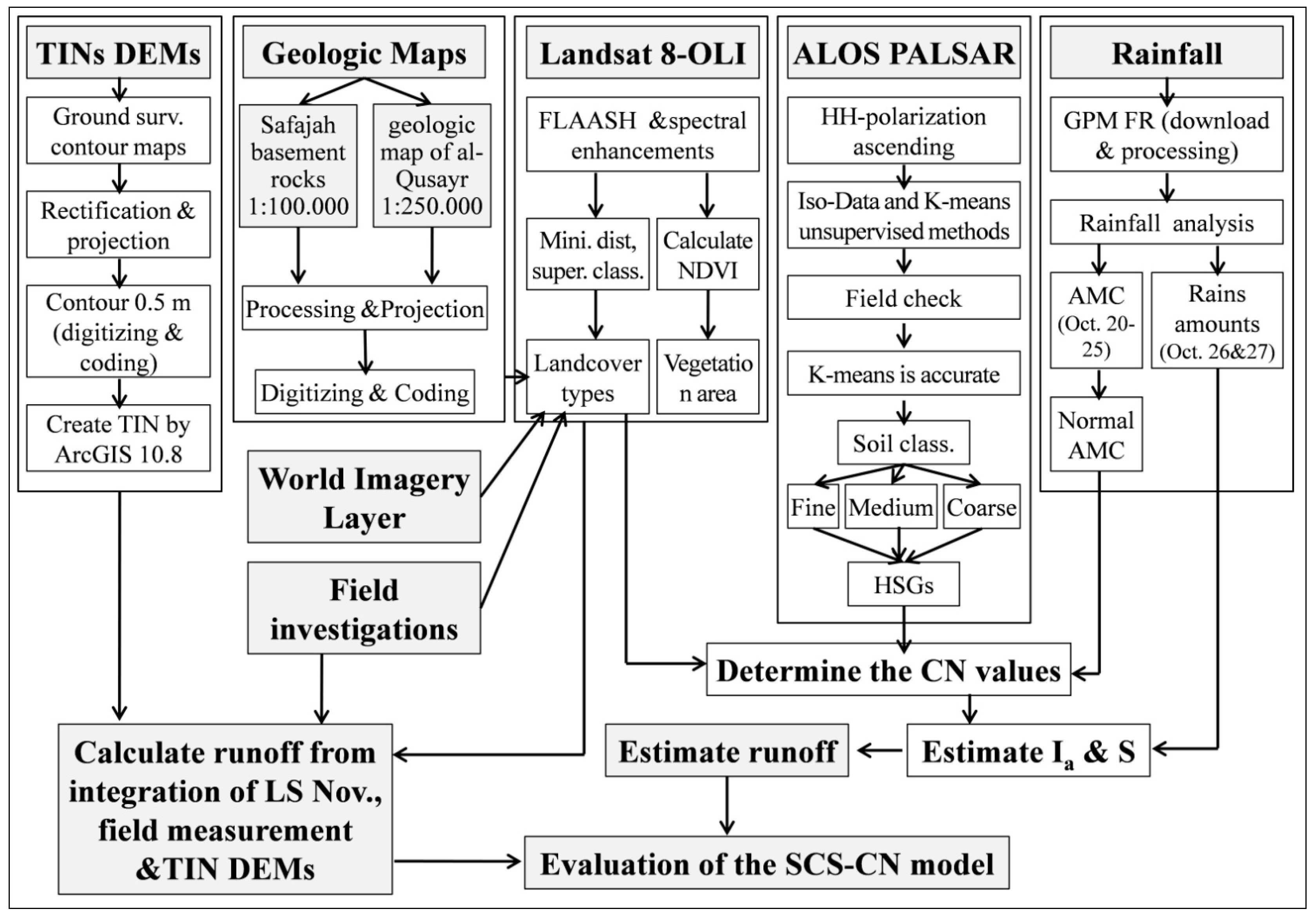
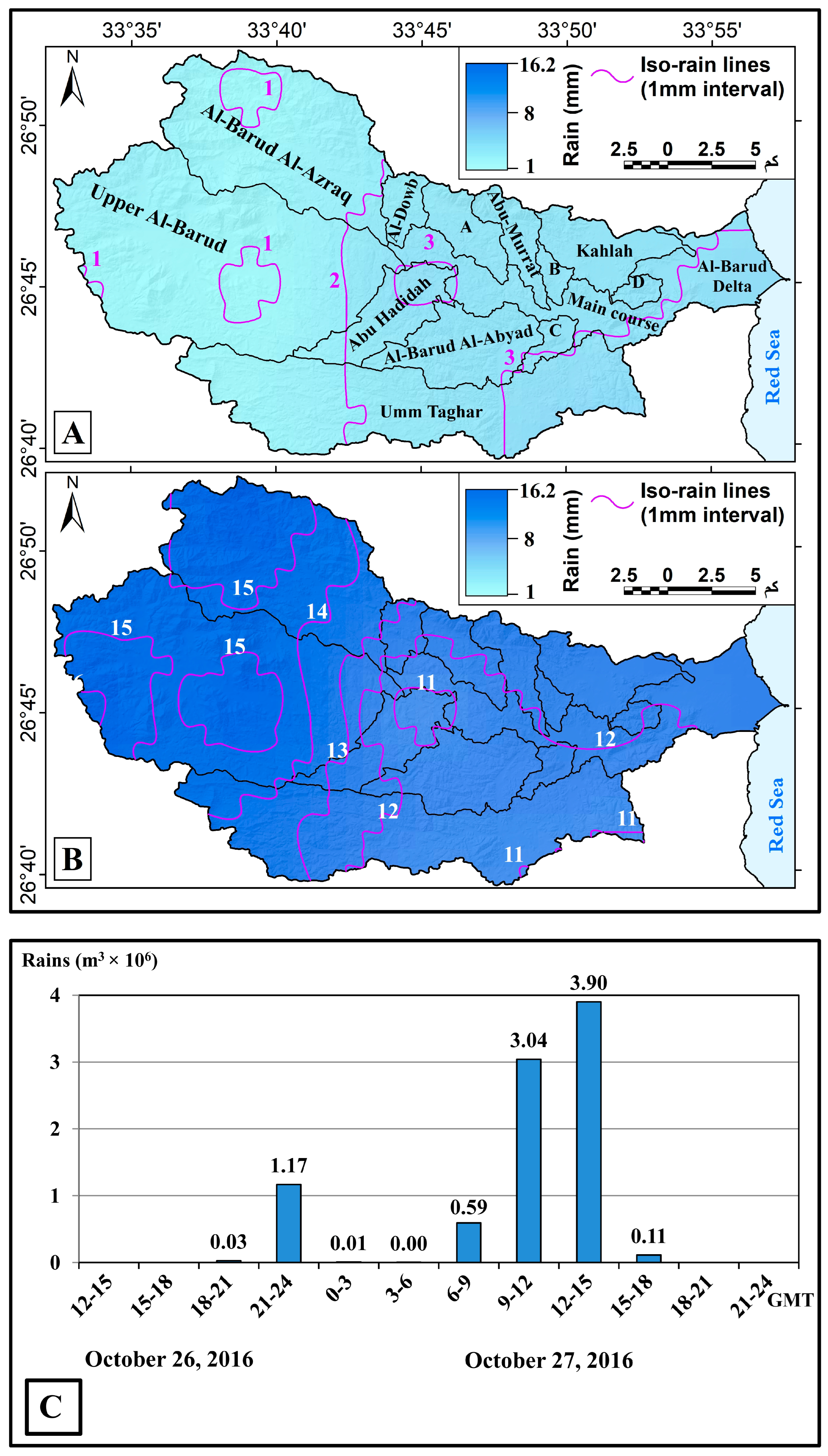
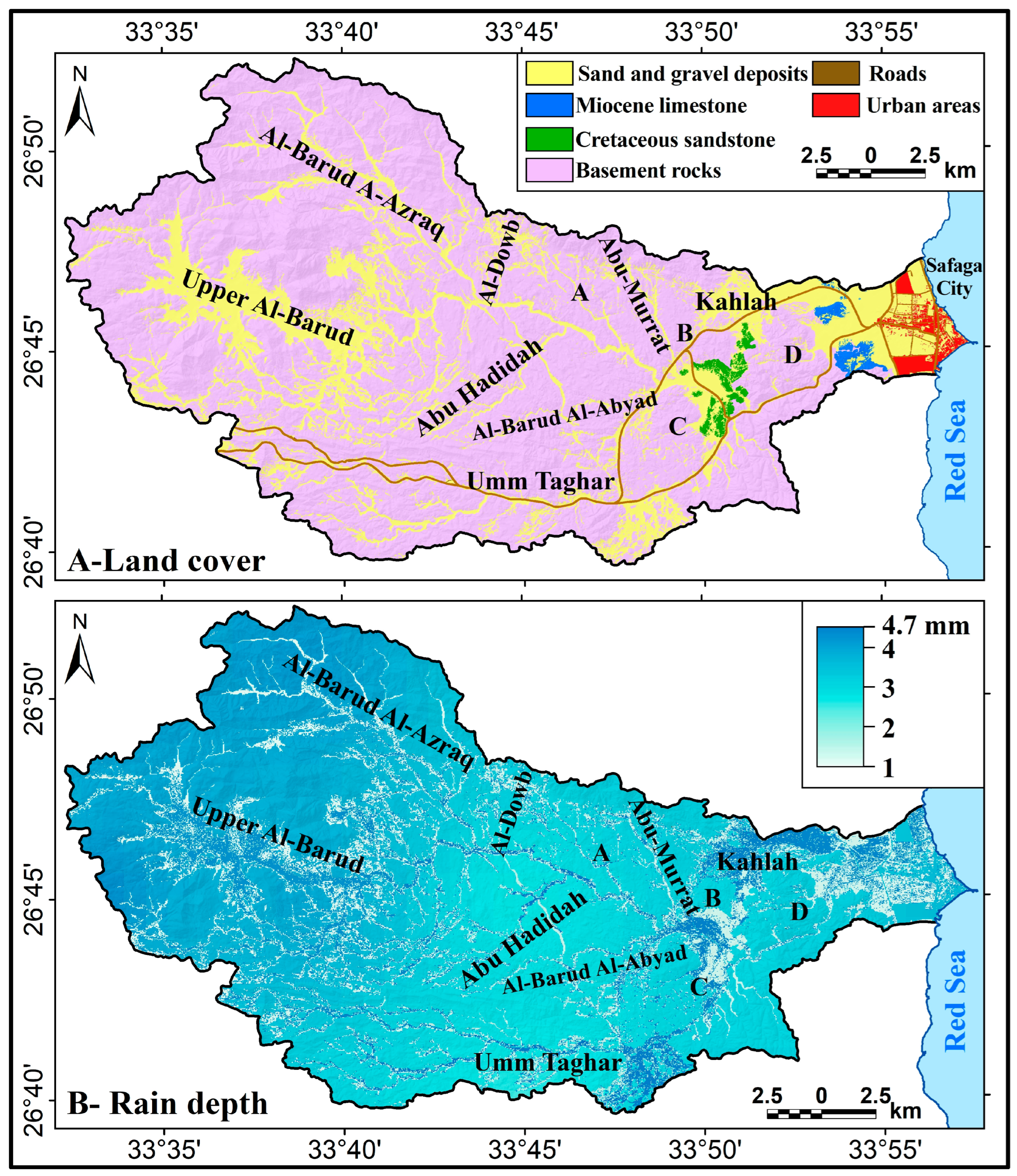
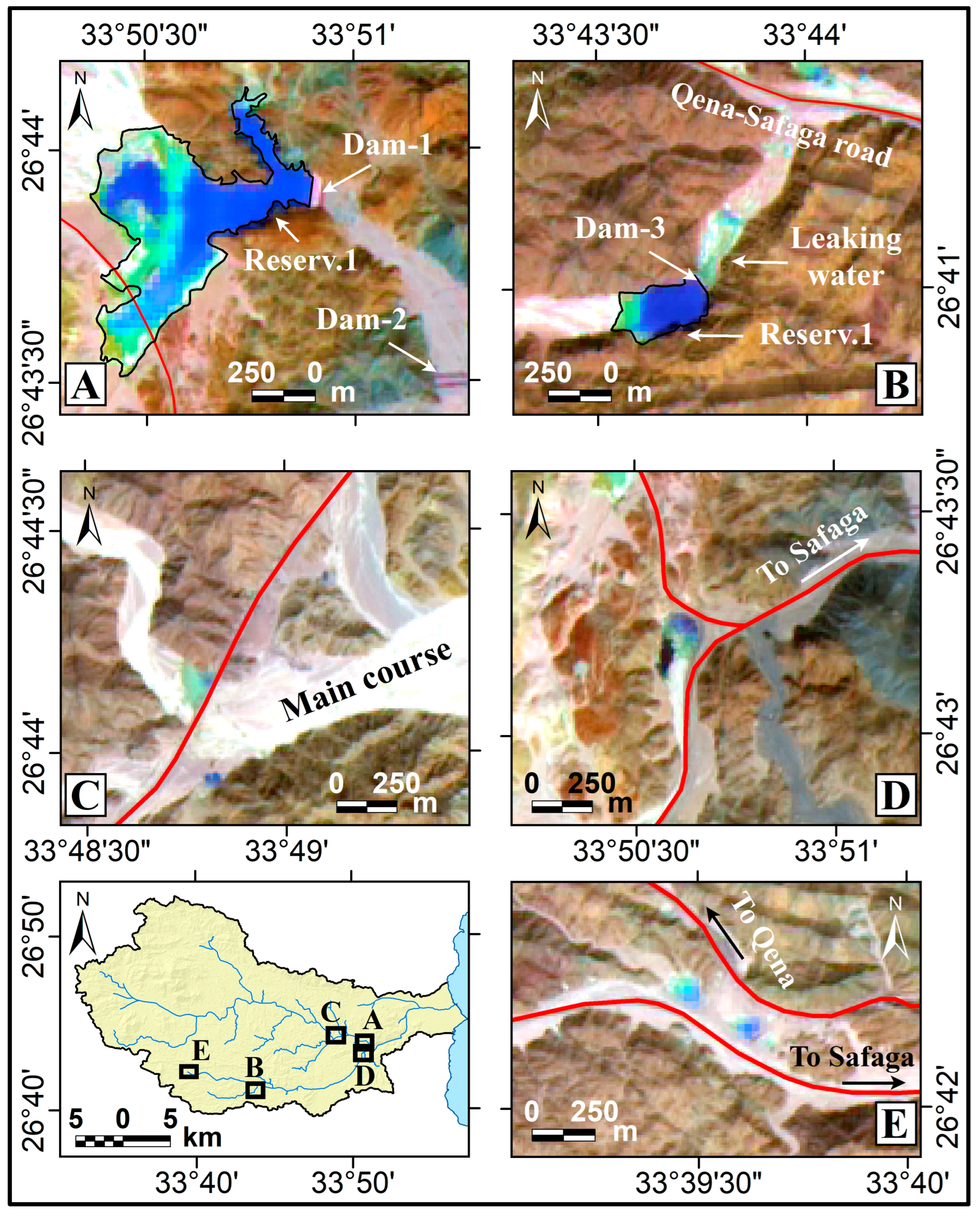
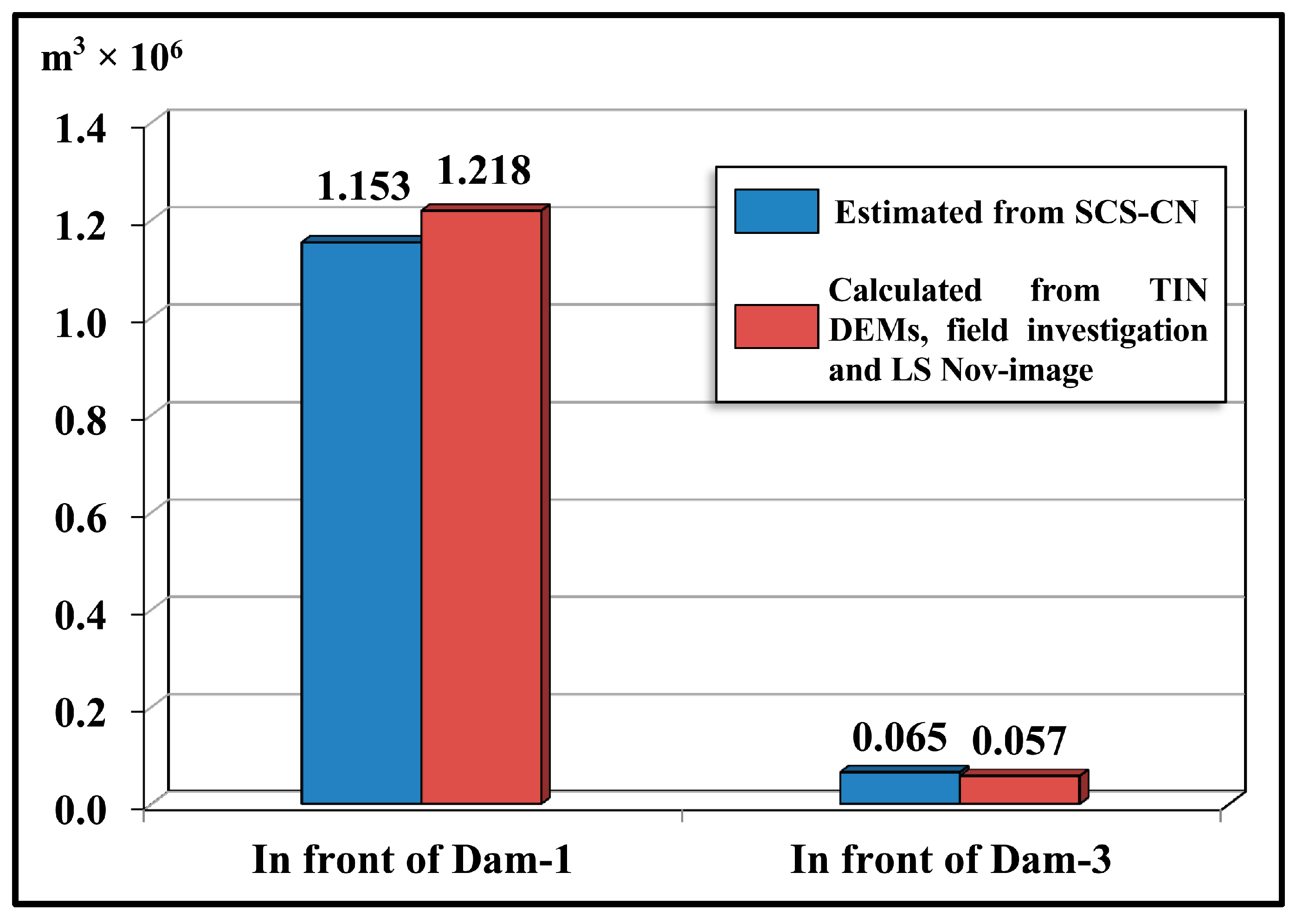
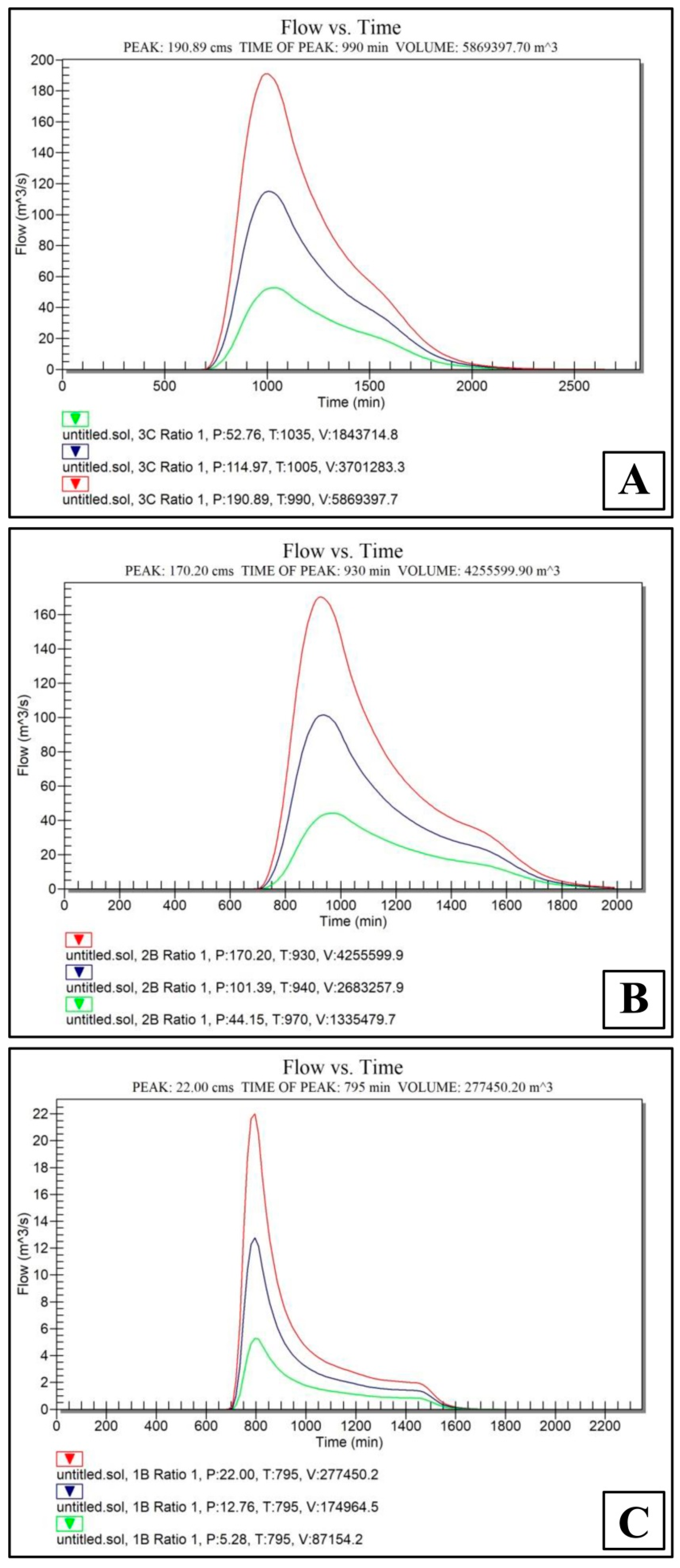
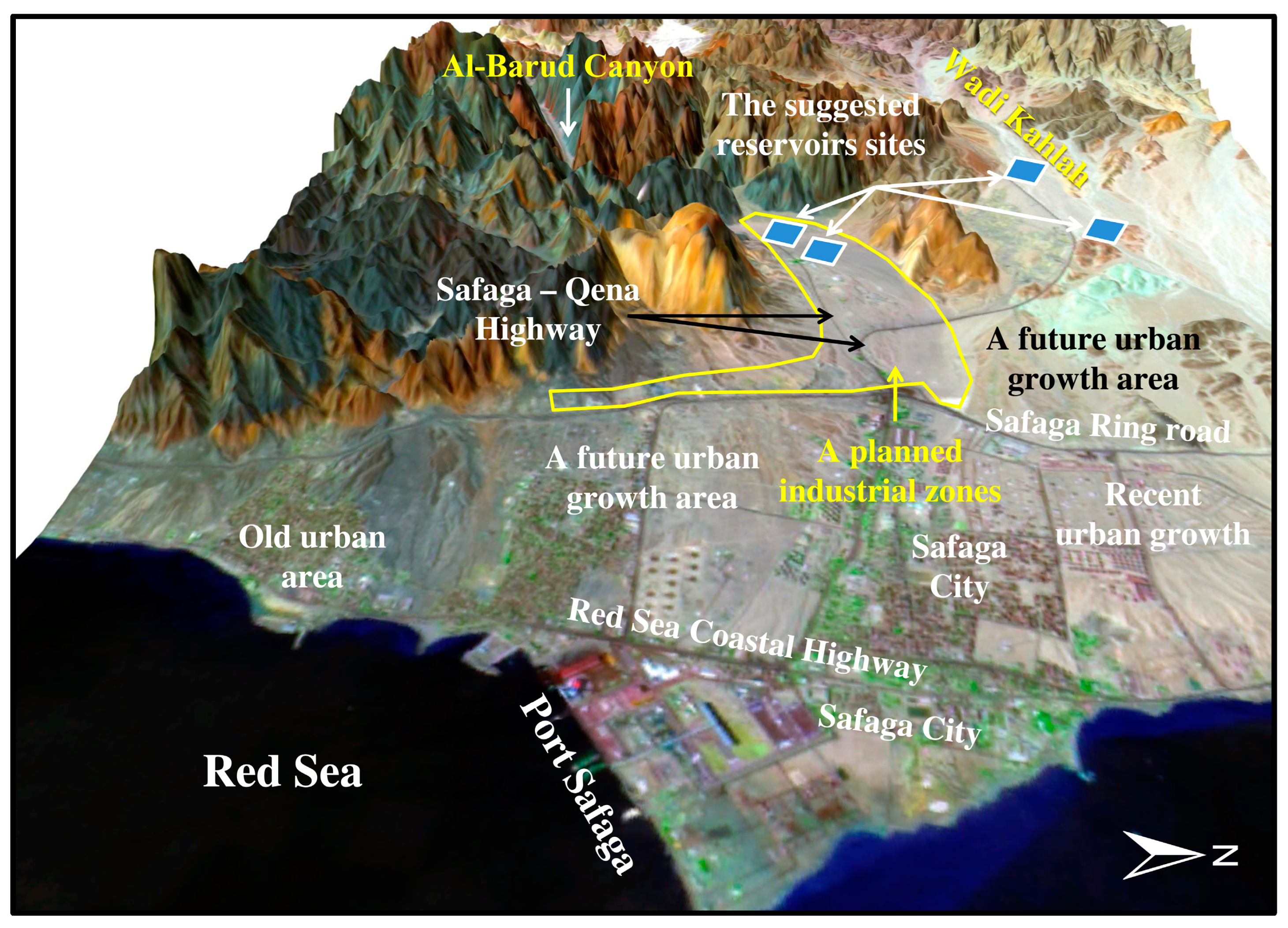
| Sub-Basins | Area (km2) | Lb (km) | W (km) | Re | Rc | Rhr | Rn | Bs (◦) | ƩNu | Rb | FS (S/km2) | Dd (km/km2) |
|---|---|---|---|---|---|---|---|---|---|---|---|---|
| Upper Al-Barud | 151.6 | 19.3 | 7.8 | 0.41 | 0.47 | 0.051 | 6 | 16.3 | 2329 | 4.5 | 15.4 | 5.5 |
| Umm Taghar | 101.5 | 24.5 | 4.1 | 0.26 | 0.22 | 0.032 | 7.2 | 17 | 3.66 | 3.8 | 30.2 | 8.3 |
| Al-Barud Al-Azraq | 85.9 | 16 | 5.4 | 0.37 | 0.46 | 0.059 | 6.3 | 21.2 | 1462 | 4.3 | 17 | 2.7 |
| Al-Barud Al-Abyad | 30.6 | 10.3 | 3 | 0.34 | 0.34 | 0.035 | 4 | 19.1 | 1297 | 4.2 | 42.4 | 9.8 |
| Abu Hadidah | 22.8 | 10.6 | 2.1 | 0.29 | 0.27 | 0.026 | 2.7 | 14.7 | 813 | 3.9 | 35.7 | 8.5 |
| Kahlah | 21.4 | 9.4 | 2.3 | 0.31 | 0.32 | 0.071 | 5.2 | 11 | 609 | 3.5 | 28.4 | 7.6 |
| Abu-Murrat | 12.3 | 7.8 | 1.6 | 0.28 | 0.33 | 0.077 | 5.1 | 21.9 | 405 | 3.4 | 33 | 7.9 |
| Al-Dowb | 8.1 | 4.4 | 1.9 | 0.41 | 0.52 | 0.104 | 2.7 | 12.7 | 159 | 3.4 | 19.6 | 4.9 |
| A | 14 | 7.2 | 1.9 | 0.33 | 0.43 | 0.093 | 5.3 | 17.2 | 467 | 4.4 | 33.3 | 7.6 |
| B | 3.8 | 4 | 0.9 | 0.31 | 0.42 | 0.045 | 2.1 | 12.8 | 209 | 3.8 | 55 | 11.6 |
| C | 5.2 | 4.5 | 1.2 | 0.32 | 0.39 | 0.058 | 2.7 | 15.8 | 205 | 3.8 | 39.7 | 9.9 |
| D | 3.7 | 3.1 | 1.2 | 0.39 | 0.55 | 0.091 | 3.2 | 28.3 | 183 | 3.6 | 50.1 | 10.2 |
| Main course | 59.6 | 21.4 | 2.8 | 0.23 | 0.09 | 0.02 | 3.3 | 13.2 | 1303 | 2.9 | 21.9 | 6.1 |
| Barud basin | 520.4 | 42.3 | 12.3 | 0.34 | 0.32 | 0.03 | 8.8 | 16.9 | 12,570 | 4.2 | 21.5 | 6.1 |
| Time | 26 October | 27 October | Time | 26 October | 27 October | Time | 26 October | 27 October |
|---|---|---|---|---|---|---|---|---|
| 0–3 | 0 | 6.7 | 9–12 | 0 | 3042.1 | 18–21 | 26.6 | 0 |
| 3–6 | 0 | 0.7 | 12–15 | 0 | 3901.2 | 21–24 | 1168.7 | 0 |
| 6–9 | 0 | 594.1 | 15–18 | 0 | 113.8 | Total | 1195.3 | 7658.6 |
| Sub-Basin | Rainfall Amounts (103 m3) | Max. Rainfall/Day (mm) | Losses (103 m3) | Runoff (103 m3) | |||
|---|---|---|---|---|---|---|---|
| 26 October | 27 October | Sum | 26 October | 27 October | |||
| Upper Al-Barud | 234.2 | 2469.4 | 2703.5 | 3 | 16.4 | 2195.4 | 508.1 |
| Umm Taghar | 264.1 | 1380.9 | 1645 | 4 | 14.6 | 1345.5 | 299.4 |
| Al-Barud Al-Azraq | 138.6 | 1406 | 1544.7 | 2.6 | 15.9 | 1242.4 | 302.2 |
| Al-Barud Al-Abyad | 94 | 392.9 | 486.9 | 3 | 12.3 | 401.3 | 85.6 |
| Abu Hadidah | 65.3 | 296.2 | 361.5 | 3.1 | 13.4 | 297.5 | 64 |
| Kahlah | 65.8 | 289.9 | 355.6 | 3 | 12.4 | 287.5 | 68.2 |
| A | 40.4 | 187.8 | 228.2 | 2.9 | 12.6 | 188 | 40.1 |
| Abu-Murrat | 35.5 | 166.7 | 202.2 | 2.9 | 12.5 | 166.3 | 35.9 |
| Al-Dowb | 21 | 113.1 | 134.1 | 2.7 | 13.1 | 111.4 | 22.7 |
| C | 17 | 67.4 | 84.4 | 3.1 | 11.9 | 68.9 | 15.4 |
| B | 11.7 | 48.7 | 60.4 | 3 | 12.1 | 48.9 | 11.5 |
| D | 11.7 | 50.9 | 62.6 | 2.9 | 12 | 51.9 | 10.7 |
| Main course | 196 | 788.7 | 984.7 | 3.3 | 12.6 | 818.1 | 166.6 |
| Al-Barud basin | 1195.2 | 7658.6 | 8853.8 | 3.7 | 16.1 | 7223.4 | 1630.2 |
| SD | 88.3 | 736.2 | 814.5 | 0.3 | 1.4 | 661.3 | 153.4 |
| Land Cover/HSG | CN | Area | % |
|---|---|---|---|
| Roads | 94 | 2.5 | 0.48 |
| Urban area | 94 | 5 | 0.96 |
| Coarse-textured soil | 59 | 15.5 | 3 |
| Medium-textured soil | 42 | 58.4 | 11.2 |
| Fine-textured soil | 42 | 50.3 | 9.7 |
| Miocene limestone | 94 | 2.1 | 0.44 |
| Cretaceous sandstone | 59 | 2.6 | 0.42 |
| Basement rocks | 94 | 384 | 73.8 |
| Area | Runoff Volume (×106 m3) | Current Storage Capacity (×106 m3) | |||
|---|---|---|---|---|---|
| 26 and 27 October 2016 | 25 years | 50 years | 100 years | ||
| Wadi Al-Barud Basin | 1.64 | 1.8 | 3.7 | 5.8 | 5.275 |
| Reservoirs 1 and 2 | 1.16 | 1.34 | 2.68 | 4.3 | 4.1 |
| Reservoirs 3 | 0.07 | 0.09 | 0.17 | 0.28 | 1.175 |
| Wadi Al-Barud main course and Wadi Kahlah | 0.28 | 0.37 | 0.85 | 1.22 | 0 |
Disclaimer/Publisher’s Note: The statements, opinions and data contained in all publications are solely those of the individual author(s) and contributor(s) and not of MDPI and/or the editor(s). MDPI and/or the editor(s) disclaim responsibility for any injury to people or property resulting from any ideas, methods, instructions or products referred to in the content. |
© 2025 by the authors. Licensee MDPI, Basel, Switzerland. This article is an open access article distributed under the terms and conditions of the Creative Commons Attribution (CC BY) license (https://creativecommons.org/licenses/by/4.0/).
Share and Cite
Khattab, M.I.; Fadl, M.E.; Megahed, H.A.; Saleem, A.M.; El-Saadawy, O.; Drosos, M.; Scopa, A.; Selim, M.K. Evaluation of the Soil Conservation Service Curve Number (SCS-CN) Method for Flash Flood Runoff Estimation in Arid Regions: A Case Study of Central Eastern Desert, Egypt. Hydrology 2025, 12, 54. https://doi.org/10.3390/hydrology12030054
Khattab MI, Fadl ME, Megahed HA, Saleem AM, El-Saadawy O, Drosos M, Scopa A, Selim MK. Evaluation of the Soil Conservation Service Curve Number (SCS-CN) Method for Flash Flood Runoff Estimation in Arid Regions: A Case Study of Central Eastern Desert, Egypt. Hydrology. 2025; 12(3):54. https://doi.org/10.3390/hydrology12030054
Chicago/Turabian StyleKhattab, Mohammed I., Mohamed E. Fadl, Hanaa A. Megahed, Amr M. Saleem, Omnia El-Saadawy, Marios Drosos, Antonio Scopa, and Maha K. Selim. 2025. "Evaluation of the Soil Conservation Service Curve Number (SCS-CN) Method for Flash Flood Runoff Estimation in Arid Regions: A Case Study of Central Eastern Desert, Egypt" Hydrology 12, no. 3: 54. https://doi.org/10.3390/hydrology12030054
APA StyleKhattab, M. I., Fadl, M. E., Megahed, H. A., Saleem, A. M., El-Saadawy, O., Drosos, M., Scopa, A., & Selim, M. K. (2025). Evaluation of the Soil Conservation Service Curve Number (SCS-CN) Method for Flash Flood Runoff Estimation in Arid Regions: A Case Study of Central Eastern Desert, Egypt. Hydrology, 12(3), 54. https://doi.org/10.3390/hydrology12030054









